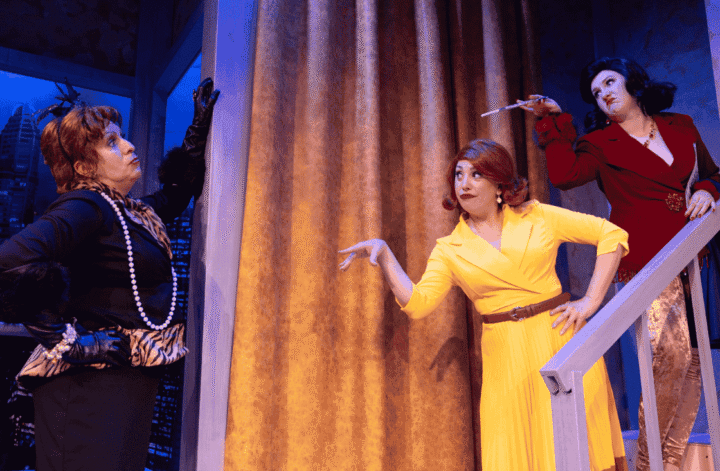Almost, Maine by John Cariani is certainly an interesting addition to Palm Beach Dramaworks’ 2021-2022 roster. After an acclaimed run in Portland in 2004, Almost Maine managed only a one month run off-broadway, but gained notoriety in its afterlife as its producibility, broad appeal, and flexible casting requirements resulted in the play becoming unexpectedly popular with high school and other regional groups.
And one can certainly see how the earnestness of Almost, Maine might be somewhat more suited to life outside the more cynical city, a sentimental crowd pleaser that it’s hard to find much to object to in besides its cheery simplicity.
The play is made up of nine vignettes that all take place in the titular town of Almost, which is so called because no one ever got around to officially incorporating it. The scenes also feature nine separate sets of characters (though characters occasionally reference those in the other sets) and take place during the same ten minute interval, the one just before the northern lights are set to appear.
“Almost” is an appropriate title, too, because each story places us in a transitional moment of the relationship it explores: we see couples who are “almost” more than friends take the leap into romance, while couples who are already committed to each other but “almost” broken up see their relationship move towards or away from that eventuality.
Then, there are the vignettes that involve chance meetings between strangers that open up “almosts” in the character’s lives, and one story’s exploration of a character’s regret regarding a choice she “almost” made.
After a short prologue that sweetly sets the mood while delivering the first few of the evening’s many laughs, I admit to being taken a little off guard by the seeming silliness with which the first substantial scene, “Her Heart,” addressed issues as potentially serious as heart failure and sudden widowhood.
But Almost Maine’s lightly absurdist approach grew on me over the course of the performance, as whimsical touches like a fatefully misspelled tattoo and physical representations of emotional maladies seemed to highlight rather than detract from characters’ very real feelings of love, loss and uncertainty.
Brandon Morris and Niki Fridh. Photo by Tim Stephien
Even the saddest of the vignettes, “Where It Went,” and “Story Of Hope,” rely on central puns rather than solely on character or story to make their impact, though the humor that each of these devices imparts also helped to soften the blow of their emotional downbeats.
Oddly, though, it was not one of these more bittersweet stories that had the greatest emotional impact on me, but rather a moment of unexpected connection at the end of “Sad and Glad,” a strangely moving moment of hopeful possibility for a character struggling to come to terms with a past heartbreak.
A cast of four plays all 19 characters that appear in the various vignettes, and actors Niki Fridh, Brandon Morris, Shane R. Tanner, and Irene Adjan certainly showcase their verve and versatility in their roles. The performers somehow remained down to earth and true to life amidst their incredible given circumstances while admirably ramping up their energy and enthusiasm whenever the situation demanded.
They also had a knack for creating the critical chemistry that must exist between their often lovelorn characters, with Adjan and Tanner’s frenzied rush to rip each other’s clothes off in the penultimate scene probably deserving of particular mention.
It was also nice to see the prospect of a same-sex romance at least alluded to in the sweet and slapstick “They Fell,” though it also seemed like the writing was falling all over itself to avoid letting the gay couple kiss.
The transporting nature of the play is enhanced by a winter-y wardrobe designed by Brian O’ Keefe and set design by Michael Amico, which consisted of a shimmering snowy backdrop and a few set pieces that slid in to add unique atmospheric touches to each vignette.
Recognition is also due to fight choreographer David A. Hyland (who also serves as the production’s male understudy) for two characters’ impressive use of an ironing board in an accidental kerfuffle, and to direction by J. Barry Lewis for setting a crisp and cohesive tone to the evening.
Brandon Morris and Niki Fridh. Photo by Tim Stephien


